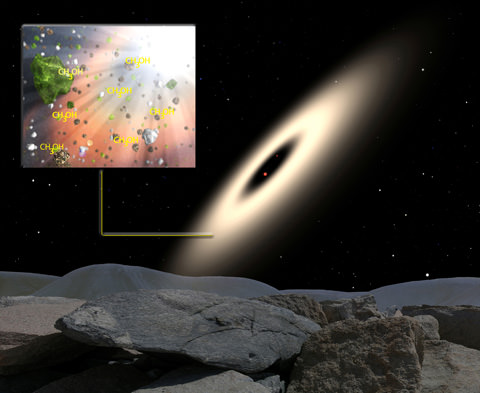Astrobiologists have discovered regions in our galaxy which might have the greatest potential for producing very complex organic molecules, the starting point for the development of life. We’ve heard before about “follow the water” in the search for life; in this case it may be “follow the methanol”…
The scientists involved, from Rensselaer Polytechnic Institute in Troy, New York, began a search for methanol, a key ingredient in the synthesis of organic molecules. According to Douglas Whittet, lead researcher of the study, “Methanol formation is the major chemical pathway to complex organic molecules in interstellar space.” The idea is to look for areas where there is rich methanol production occurring. In the large clouds of dust and gas that give birth to new stars, there are simpler organic molecules like carbon monoxide. Under the right conditions, carbon monoxide on the surfaces of dust grains can interact with hydrogen, also found in the clouds, to create methanol. Methanol can then become a steppingstone to create the more complex organic molecules, the types needed for life itself. But how much methanol is out there, and where?
It appears to be most abundant around a small number of newly-formed stars, where it makes up to 30 percent of the material around those stars. In other areas though, it is in much smaller amounts, or none at all. In the cold dust and gas clouds that will eventually produce new stars, it was found to exist in the 1 to 2 percent range. Hence, there appear to be “sweet spots” where conditions are suitable for the chain reactions to occur, depending on how fast the needed molecules can reach the dust grains. It can mean the difference between a “dead end” for additional development or an “organic bloom.” As described by Whittet: “If the carbon monoxide molecules build up too quickly on the surfaces of the dust grains, they don’t get the opportunity to react and form more complex molecules. Instead, the molecules get buried in the ices and add up to a lot of dead weight. If the buildup is too slow, the opportunities for reaction are also much lower.”
So some places may be much more likely to have the conditions necessary for the development of life than others. What about our own solar system? How does it compare? By studying the methanol amounts in comets, relics from the beginning of the solar system, the scientists have concluded that the methanol abundance back then was about average. Not a dearth of the stuff, but not a “sweet spot” really, either. Yet here we are… or, as Whittet put it, “This means that our solar system wasn’t particularly lucky and didn’t have the large amounts of methanol that we see around some other stars in the galaxy. But, it was obviously enough for us to be here.”
The paper, titled “Observational constraints on methanol production in interstellar and preplanetary ices,” will be published in the Nov. 20 edition of The Astrophysical Journal and is a collaboration between Rensselaer, NASA Ames Research Center, the SETI Institute and Ohio State University.
Source: Universe Today

No hay comentarios:
Publicar un comentario